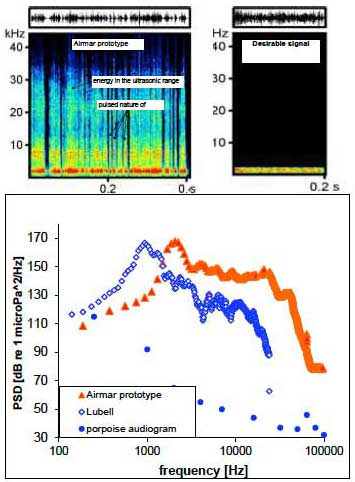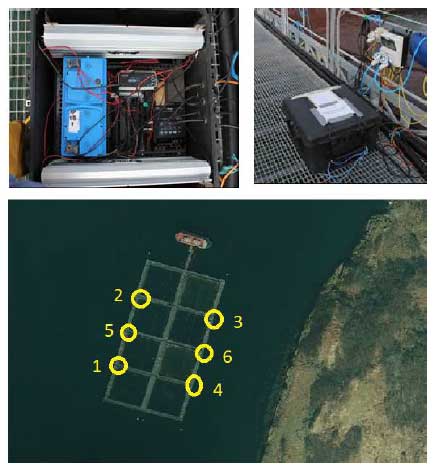Acoustic deterrence using startle sounds: long term effectiveness and effects on odontocetes
This report presents the findings of field experiments aimed as testing the long-term effectiveness of a new deterrence method (acoustic startle reflex)on pinnipeds.
The experimental startle setup
Following our previous study we entered into a commercial agreement with Airmar to develop a prototype in view of general production and marketing of a device. This development was funded by Airmar and the University of St Andrews. Over the project, Airmar produced two devices both of which failed to produce the required sounds (Fig 1). After 2 years with Airmar, we decided to try to find alternative ways of commercialisation independently. We therefore assembled our own equipment for the tests described in this project.
Fig 1: Spectrogram of an emission by a Airmar prototype (left) in comparison to the desirable signal (right). The lower panel shows power spectral density plots for the Airmar prototype and the Lubell loudspeakers used in this study. Note the high frequency scatter of the Airmar signal which would have compromised target-specificity of the device.

Fig 2: Acoustic deterrent device that was built for long-term experiment described in this report. The upper panel shows the device deployed at the test site. The lower panel shows an aerial view of the fish farm with all transducer positions that were used in this study. However, not that a maximum of only 4 transducers was ever active at any one time.

We used Lubell 9162T loudspeakers (Lubell labs Inc.) as underwater sound projectors since they were capable of emitting sufficient source levels in conjunction with reduced high-frequency scatter. The system we produced consisted of 2-4 sound projectors, two stereo Lanzar Vibe 292 power amplifiers, an Edirol R-44 4-channel recorder (used as a player), various types of marine power supplies ( e.g. CTek M200) connected to the generator of the fish farm and a car battery. The car battery was charged from the power supply whenever the generator was running, while the equipment ran from the battery for the rest of the time. All components were mounted on a metal frame in a water-proof pelican case and loudspeakers were connected with cables to the main control box (Fig 2). The initial setup involved two loudspeakers, although approximately a month after deployment, two additional speakers were installed. One of these was removed again later to enable additional tests on other farms. The control box was deployed in the centre of the fish farm; transducer positions are shown in figure 2. The overall deployment period of the equipment was 13 months. The two main loudspeaker configurations consisted of speakers running at positions 1-4 (for approx. 4 months) and at positions 1, 2 & 6 (for approx. 8 months). Various components failed during the 13 months experimental period and substantial maintenance work had to be carried out to keep the system running. The breakdown of two power amplifiers, a power supply and various accidental cable cuts resulted in various "off-periods" throughout the experimental study. A complete record of operation, loudspeaker configurations and reasons of failure is provided in appendix 1. The technical failures experience during the project highlights the importance of engineering an industrial system that can withstand the harsh environment on a fish farm. Two additional setups were produced for tests on problem sites in Orkney and Argyll, one consisting of two transducers, the other of a single transducer. The system deployed in Orkney was flooded in a severe gale 2 weeks after deployment with all components being destroyed.
Contact
There is a problem
Thanks for your feedback